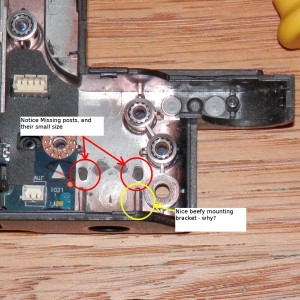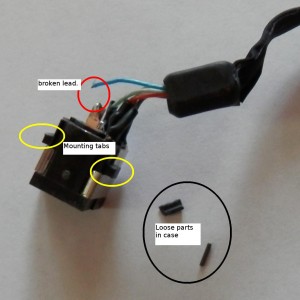Fedora 19 kernel 3.11 NVidia 325 problem with NVidia 8200
My main computer is based on a ASUS M3N78-VM motherboard with a built-in NVidia GeForce 8200 GPU. After letting Fedora 19 upgrade to the latest kernel and corresponding NVidia drivers (via akmod), the display went crazy a few seconds after logging in, and then the system would lock up completely. Fortunately I wasn’t the first to encounter this problem, the solution is simple enough, as outlined in the thread below:
https://bbs.archlinux.org/viewtopic.php?id=168040
Simply add this line (as root) to /etc/modprobe.d/modprobe.conf (or create this file if it is missing):
options nvidia NVreg_EnableMSI=0Now the frustrating part is why should the drivers now default to enable this feature, if it is known to cause such major problems? I’m sure it accelerates the graphics on many of the newest GPU’s, but the 8200 isn’t that terribly old.
Dell Studio 1440/14z power connector
Speaking as an engineer, sometimes you really have to wonder what another engineer was thinking when something simple breaks. We have a 4 year old Dell Studio 14z that suddenly started shutting down randomly, usually within seconds of booting up. The battery was showing a full charge. Also, the DC power connector was strangely loose inside the case.
As the photos below show, the mounting slot in the case was a very poor structural design. Once the undersized mounting brackets broke off, the connector wobbled around until one of the wires finally broke. Fortunately replacement parts are available outside of Dell, since they don’t sell repair parts for their own products???? Anyway, while I could have re-soldered the wire, all the other wires would still be suspect. Better to use a new DC plug wiring harness. However, how to secure this in the case? Epoxy may be the best option.
Fedora 17 -> Fedora 19 upgrade
Somehow I neglected to upgrade to Fedora 18, which likely made the transition to Fedora 19 more complex, or simply delayed and multiplied the required changes. In general, “FedUp” works well. However, somehow the NVidia video drivers always create problems. This was exacerbated by having some ubuntu versions of the gnome-desktop in fc17. I ended up un-installing most of gnome and also the kmod-nvidia drivers and re-installing them to clear up a few things. Thus far, the only desktop that works for me is cinnamon, gnome-classic and kde both abort.
Also, several modules were missing from httpd:
yum install mod_ldap mod_authnz_external pwauth
thus far, I haven’t found mod_disk_cache, mod_authz_default, mod_authn_default, or mod_authn_alias.
The right way to do this is swap in the new/etc/httpd/conf/ httpd.conf.rpmnew in place of httpd.conf, and map in any important settings as needed.
gnucash seg-fault due to LD_LIBRARY_PATH
I’ve used gnucash to manage my finances since 2001. For quite some time, after one of the Fedora upgrades, gnucash would always die after the spash screen with a segmentation fault. However, if I ran it as a different user it would work fine. I finally traced it down to a stale LD_LIBRARY_PATH variable value. Removing this bad path fixed gnucash!














